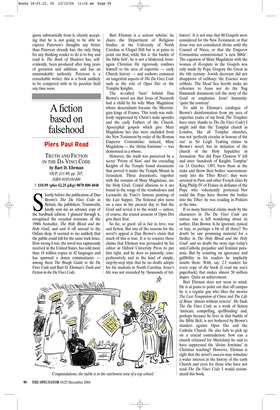A fiction based on falsehood
Piers Paul Read
TRUTH AND FICTION IN THE DA VINCI CODE by Bart D. Ehrman OUP, £11.99, pp. 207, ISBN 0195181409 ✆ £10.99 (plus £2.25 p&p) 0870 800 4848 Shortly before the publication of Dan Brown’s The Da Vinci Code in Britain, the publishers, Transworld, kindly sent me an advance copy of the hardback edition. I glanced through it, recognised the recycled nonsense of the 1980s bestseller, The Holy Blood and the Holy Grail, and sent it off unread to the Oxfam shop. It seemed to me unlikely that the public could fall for the same trick twice. How wrong I was: the novel was rapturously received in the United States, has sold more than 18 million copies in 42 languages and has spawned a dozen commentaries among them The Rough Guide to the Da Vinci Code and Bart D. Ehrman’s Truth and Fiction in the Da Vinci Code. Bart Ehrman is a serious scholar: he chairs the Department of Religious Studies at the University of North Carolina at Chapel Hill but is at pains to point out that, while this is ‘the buckle of the bible belt’, he is not a blinkered, bornagain Christian. He rigorously confines himself to his area of expertise — early Church history — and eschews comment on tangential aspects of The Da Vinci Code such as the role of Opus Dei or the Templar Knights.
The so-called ‘facts’ behind Dan Brown’s novel are that Jesus of Nazareth had a child by his wife Mary Magdalene whose descendants became the Merovingian kings of France. This truth was ruthlessly suppressed by Christ’s male apostles and the early Fathers of the Church. Apocryphal gospels which give Mary Magdalene her due were excluded from the New Testament by order of the Roman Emperor Constantine: instead, Mary Magdalene — the ‘divine feminine’ — was demonised as a whore.
However, the truth was preserved by a secret ‘Priory of Sion’ and the crusading Knights of the Temple found documents that proved it under the Temple Mount in Jerusalem. These documents, together with the remains of Mary Magdalene, are the Holy Grail. Coded allusions to it are found in the songs of the troubadours and Leonardo da Vinci’s famous painting of the Last Supper. The fictional plot turns on a race in the present day to find the Grail and reveal it to the world — unless, of course, the crazed assassin of Opus Dei gets there first.
So far, so good: all is fair in love, war and fiction. But one of the reasons for the novel’s appeal is Dan Brown’s claim that much of this is true. It is to counter those claims that Ehrman was persuaded by his editor at Oxford University Press to put him right, and he does so patiently, comprehensively and in the kind of simple, step-by-step style that he no doubt adopts for his students in North Carolina. Jesus’s life was not recorded by ‘thousands of fol lowers’. It is not true that 80 Gospels were considered for the New Testament, or that Jesus was not considered divine until the Council of Nicea, or that the Emperor Constantine commissioned ‘a new Bible’. The equation of Mary Magdalene with the woman of ill-repute in the Gospels was only made by Pope Gregory the Great in the 6th century. Jewish decorum did not disapprove of celibacy: the Essenes were celibate. The Dead Sea Scrolls make no reference to Jesus nor do the Nag Hammadi documents tell the story of the Grail or emphasise Jesus’ humanity: ‘quite the contrary’.
To add to Ehrman’s catalogue of Brown’s disinformation from my area of expertise (sales of my book The Templars have risen thanks to The Da Vinci Code) I might add that the Templar church in London, like all Templar churches, was not ‘perfectly circular in honour of the sun’ as Sir Leigh Teabing claims in Brown’s novel, but in imitation of the church of the Holy Sepulchre in Jerusalem. Nor did Pope Clement V kill and inter ‘hundreds of Knights Templar’ on 13 October, 1307, burn them at the stake and throw their bodies ‘unceremoniously into the Tiber River’; they were arrested in Paris and other French cities by King Philip IV of France in defiance of the Pope who vehemently protested. Nor could the Pope have thrown the bodies into the Tiber: he was residing in Poitiers at the time.
If so many historical claims made by the characters in The Da Vinci Code are untrue one is left wondering about its author, Dan Brown. Is he ignorant, cynical or lazy, or perhaps a bit of all three? No doubt he saw promising material for a thriller in The Holy Blood and the Holy Grail: and no doubt the story taps today’s anti-Catholic prejudice and feminist paranoia. But by counting on ignorance and gullibility in his readers he implicitly insults them. With, say, 2.5 readers for every copy of the book (I read my son’s paperback) that makes almost 50 million dupes. Quite an achievement.
Bart Ehrman does not seem to mind. He is at pains to point out that off campus he is a regular guy who likes the movies The Last Temptation of Christ and The Life of Brian ‘almost without reserve’. He finds The Da Vinci Code as a work of fiction ‘intricate, compelling, spellbinding’ and, perhaps because he lives in that buckle of the Bible Belt, is not bothered by Brown’s slanders against Opus Dei and the Catholic Church. He also fails to pick up on a crucial contradiction: how can a church criticised for Mariolatry be said to have suppressed the ‘divine feminine’ in Christian teaching? However, Ehrman is right that the novel’s success may stimulate a wider interest in the history of the early Church and even for those who have not read The Da Vinci Code I would recommend this book.

















































































 Previous page
Previous page